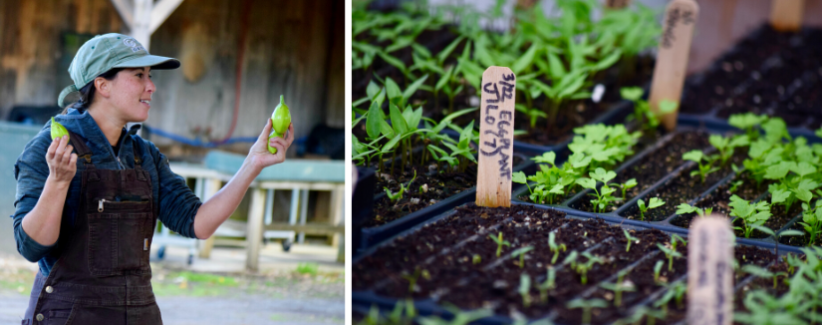Culturally Considerate: Growing Crops that Our Clients Want

Smells of molé simmering on the stove. Red chiles decorating the walls. A bloated belly from cheesy dishes. These are a few of my favorite food memories.
Food connects us to our ancestors. Our spirits crave the foods our ancestors grew and ate. I am a white Mexican-American reconnecting with my ancestors through food and I want the people who eat the food that I grow to feel connected in this way, too.
Last year was my first growing season spent working at Gaining Ground. Through my role managing our food distribution, I built relationships with the volunteers, managers, and chefs from the organizations that receive our vegetables. As I took time this past winter to reflect on my favorite conversations from the months before, I felt particularly inspired by those chats that resulted in me hungrily salivating and daydreaming of dishes that I had never before cooked from cultures unfamiliar to me.

In 2021, during partner site visits and weekly distributions, we asked: “Is there anything we aren’t growing that your clients want?” Some responses included more hot peppers, okra, jiló eggplant, collard greens, and mangos. (I wish we had the climate for mangos!)
These conversations, along with the annual feedback surveys we received from our partners, compelled us to add a few new crops to our 2022 crop plan. While we are limited by our northeastern climate, there are many crops that can still grow here, including el guajillo peppers, habañero peppers, okra, jiló, collard greens, tatsoi, and more varieties of bok choy. Since this is the first time Gaining Ground has grown some of these crops, we are testing out small amounts of each.
We will observe their growth habits, yields, and relationship with our soil. We will also learn from inevitable mistakes and deepen our personal relationships with each crop.
Our hope is that through our trials of these crops, we can grow them more knowledgeably and in larger amounts in the years to come.

According to partner surveys we distribute each season, our customers are African, Asian, Latinx, Afro-Caribbean, and White. I would be remiss to write a piece about growing culturally relevant crops without stating that a disproportionate number of people experiencing food apartheid in the U.S. are Black, Indigenous, and People of Color (BIPOC) whose ancestors ate and grew foods that are different from what fills a majority of grocery store shelves today.
Food apartheid is a term created by farmer and activist Karen Washington to describe how racism and historic patterns of oppression have led to inequitable access to healthy, affordable food and increased rates of chronic disease within BIPOC communities.
This inequity in food access is a complex problem, but one that is, in short, rooted in a history of systemic injustice within and without our food system—and includes examples such as the exploitation of farm laborers (including my Mexican ancestors past and present) and the commodification of farm land

People experiencing food insecurity have a right to choose what foods to feed themselves and to fill their homes with the foods that their spirits crave. Growing culturally relevant crops increases food autonomy. Due to limited funding and resources, food pantries and food access programs have less agency in what they can offer to clients than other food hubs, such as grocery stores, farmer’s markets, and food co-ops. For this reason, Gaining Ground works to always diversify our offerings to partners, especially with foods that are not frequently donated by other organizations and institutions.
This month, I will harvest the guajillo peppers to make molé. With each nostalgic bite I will thank my Mexican ancestors for saving these seeds year after year. I will share my recipe with food pantry managers and hear about how their customers are using the peppers. Together, we will celebrate a relationship with food that transcends calories and incorporates culture.